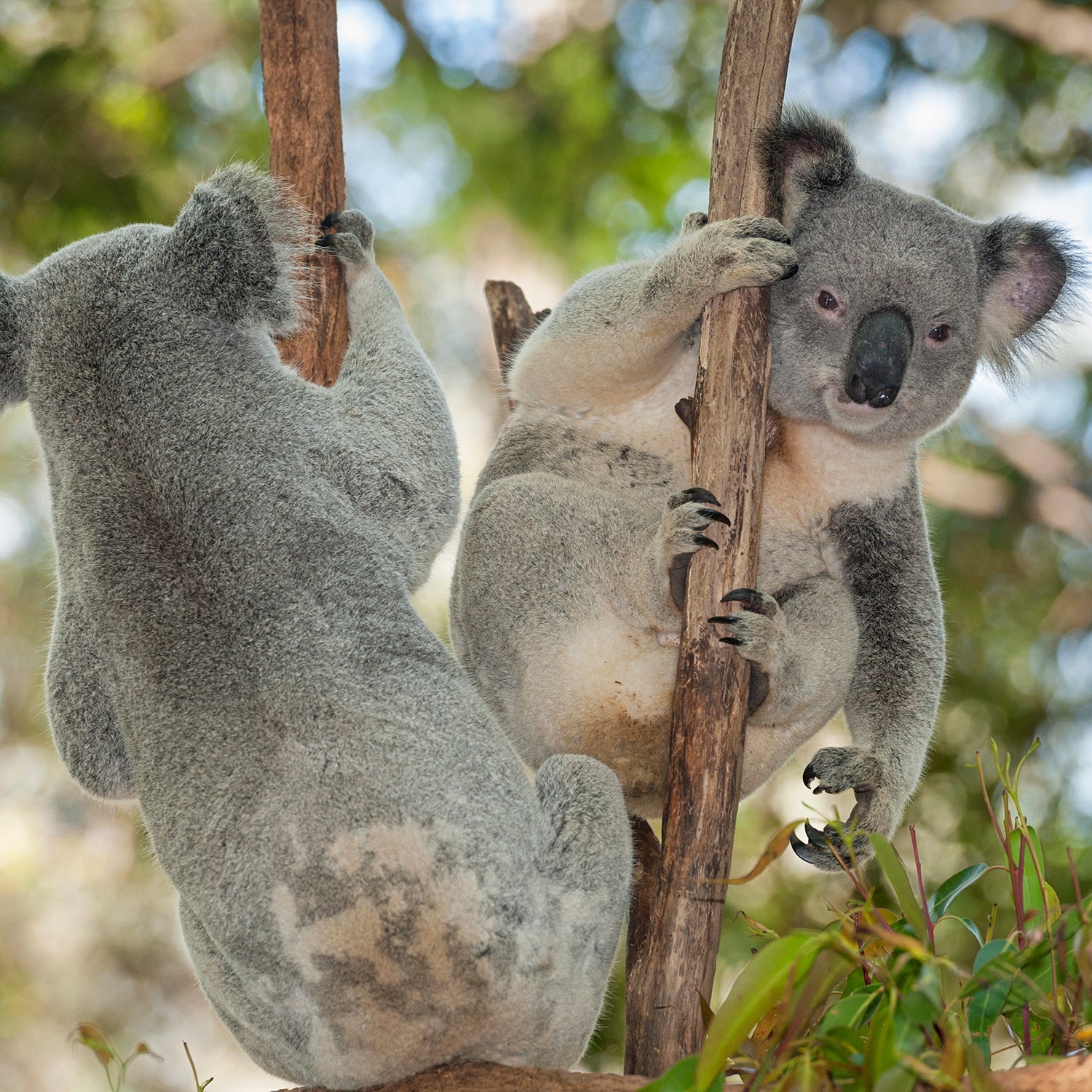Koalas, charismatic and cuddly as they are, are not well equipped to deal with the threats of the modern world. The marsupials are maimed in large numbers by domesticated dogs, splattered in droves across Australia’s country roads, and subjected to the slow, steady destruction of habitat that’s made the continent home to almost half the mammalian extinctions of the modern era. That’s why George Wilson, a conservationist, thinks the government should lease koalas—and all threatened animals—to private citizens.
In a in the journal Conservation Letters, Wilson, an adjunct professor at the Australian National University who spent decades working for Australian state conservation agencies, proposes an experiment in which certain populations of endangered species would be moved from public areas where they’re threatened and relocated to privately held lands with suitable habitats. Private lands could mean anything from golf courses to game reserves owned by businesses, philanthropists, or any stewardship group willing to protect the animals, Wilson says. (Those land holders could then potentially leverage the animals as eco-tourism opportunities.)
But why would anyone rent a pack of endangered species? Money, of course. Eco-tourism is big business in Australia. Koala-related tourism alone generates at least $1.1 billion per year, .
Wilson knows the plan sounds a little nutty. “Once you’re in semi-retirement from the government, you can have a go at a few left-field ideas, and if you offend a few people it’s okay,” he says.
But the idea has gotten some serious attention: in October, Dick Smith, one of Australia’s richest philanthropists and a prominent environmentalist, publicly came out in support of the idea. “This is lateral thinking at its best,” . “I support the initiative.” Then Australia’s Threatened Species Commissioner �ٳ����Sydney Morning Herald in October that “building partnerships with private sector institutions is essential to winning the fight against extinction.”
Tourists from around the world visit Australia to glimpse its unique wild animals, like bettongs, koalas, Tasmanian devils, and hairy-nosed wombats. On the whole, “nature based tourism” attracts 3.3 million foreign visitors to the country and contributes $23 billion to the Australian economy each year, . But the state, which technically owns the animals, has failed to protect endangered mammals and it has mismanaged populations elsewhere, Wilson says. Koalas, for instance, one of the country’s iconic creatures, are threatened in some areas, while overpopulated in others. There are so many in New South Wales, for instance, that the government in recent years. “We have a national asset here going the wrong direction,” Wilson says. “The government doesn’t have enough money to take this conservation on.”
Unsurprisingly not everyone thinks that renting wildlife to Australia’s one-percenters is the ecological solution we’ve been looking for.
“Once things get into the private sector, people may not always be well-intentioned toward wildlife,” says Ralf Buckley, a professor and chair of International Ecotourism Research at Griffith University in Queensland, Australia, who is distrustful that private landowners would make better wildlife managers than the government. Plus, he says, Wilson’s plan is unnecessary. “One of the things Wilson and company say is if private landowners could lease wildlife, that would provide additional habitat, for example, on golf courses,” Buckley says. “But native wildlife can go to those places now. There’s no restriction on movement of those animals—they can move by themselves. They already spread wherever there is native habitat.”
There’s also the potential for the economic incentive of holding valuable animals to develop into a key driver under Wilson’s plan. “Imagine if all the tigers in the world were owned by the Koch Brothers,” says Buckley, only half joking. “Then they could turn around and say unless you give us a trillion dollars, we’re going to kill them all because we don’t get a give shit about tigers.”
Is renting wildlife to Australia’s one-percenters the ecological solution we’ve been looking for? A lot of people don’t think so.
Owning large numbers of tigers or lions may sound like something a Bond villain would do, but the privatization of wildlife has been successful in southern and eastern Africa. There, governments have a long history of letting individuals own animals, and big game reserves provide tens of thousands of acres of sensitive habitat while providing a profit motive to keep it in tact. Wilson estimates that 10 percent of South Africa’s land is in conservation due to private ownership of animals.
Critics say the full-scale privatization of animals wouldn't work in Australia like it has in parts of Africa. “Just because a system works in another country does not mean it can be transferred,” Buckley says. “It’s messy. Cultures and laws and histories and social expectations are different between countries.” Indeed, Jeff Bennet, a professor of environmental management at the Australian National University, says, “You’d never get private ownership of wildlife in Australia. It seems to be politically unacceptable—the environmental movement would never have that.”
“But what Wilson is advocating is a leasing movement,” Bennet says. “The point he is making is that in many circumstances, there are surpluses of some species—for instance, the iconic koala is very, very rare in some areas but it’s overabundant in some other areas…so why don’t we allow trade to take place?”
“We expect people will want to do it for altruistic reasons,” Wilson says. “I’ve heard interest from mining companies, philanthropists, private landowners.”
In spite of the current trend toward deregulation in the U.S., the private ownership of wildlife here is unlikely to come about anytime soon, says Reed Watson, executive director of the Property and Environment Research Center, a Bozeman, Montana, think tank “dedicated to improving environmental quality through property rights and markets.” But the idea is not as farfetched in America as many traditional conservationists may think. State governments are already using market forces to incentivize conservation. Colorado, for instance, pays ranchers when elk rummage through their crops; Montana, however, does not.
“When Joe Schmo farmer sees a hundred elk wonder over from his neighbor’s farm, does he say ‘Oh man, this is great’? Or does he have to bear the cost of those 100 elk?” Reed says. “We want landowners to think of wildlife as an asset. We think that’ll lead to better wildlife outcomes.”
“It’s an interesting question, if not legally then politically—what are we comfortable with?” Reed says. “My read on it is this is a state issue, so you have 50 different labs for experimentation. States have the authority to adopt something like that.”
Back in Australia, Wilson says that in spite of folk’s discomfort with the idea of leasing endangered species, the plan is still worth trying. “Business as usual is not working,” he says. “We’ve got to do something.”


